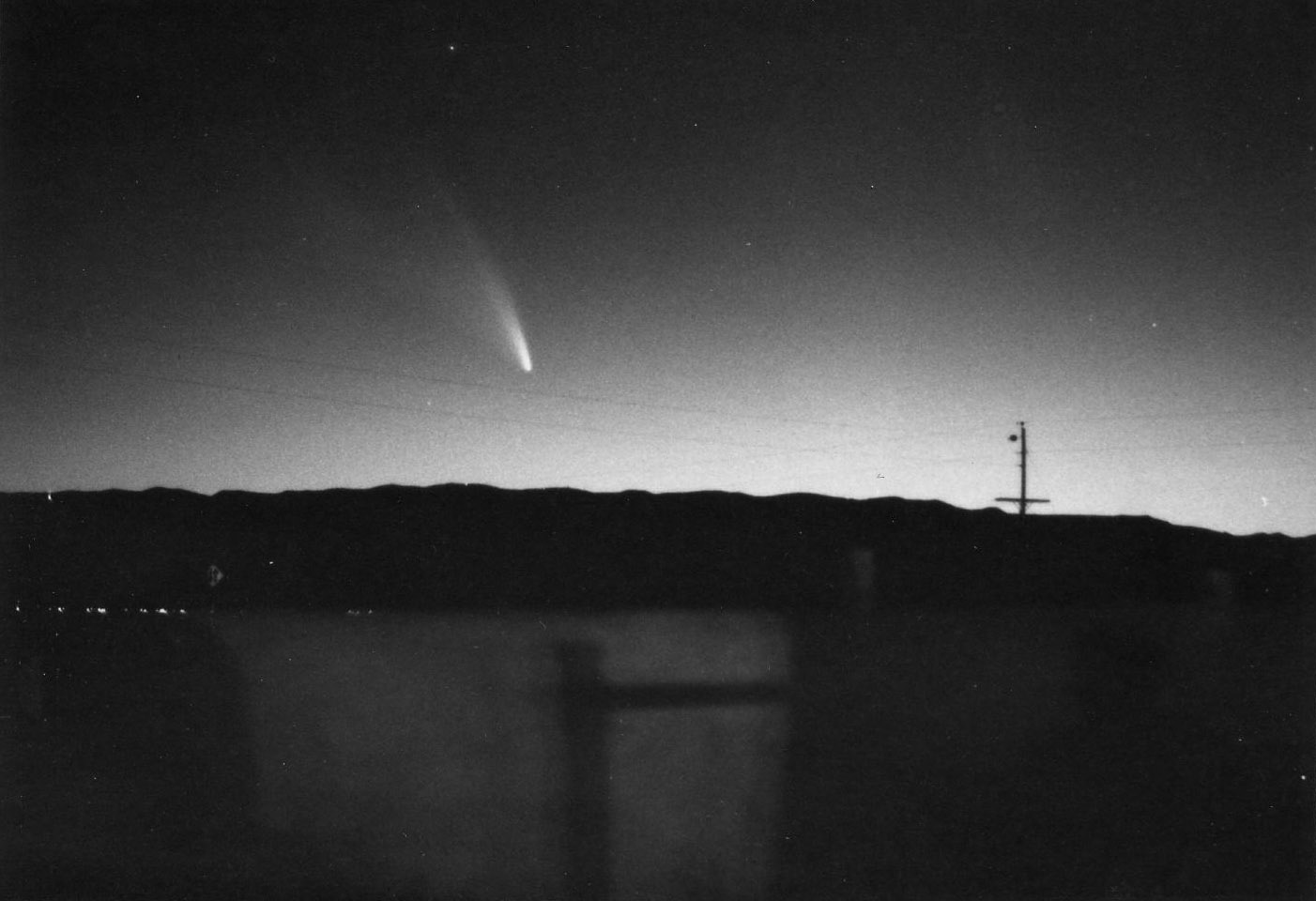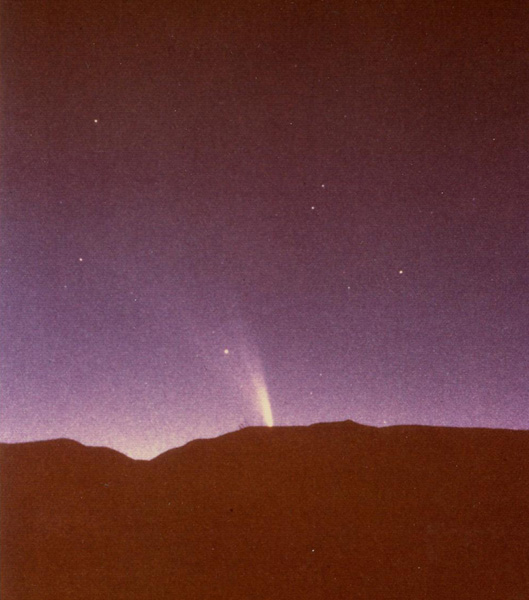
Perihelion: 1976 February 25.22, q = 0.197 AU
What I consider to be the best comet I have ever seen was missed by most of the general public. Part of this was due to the fact that it put on its best appearance in the sleepy hours before dawn, but a large part of it was due to the fact that astronomers were still reeling a bit from the disappointing performance put on by Comet Kohoutek 1973f two years earlier. (I discuss this comet in last week’s “Special Topics” presentation, and it is a future “Comet of the Week.”) Furthermore, the initial projections did not suggest anything especially spectacular; instead, they suggested something more like the performance Comet Kohoutek actually achieved. (It’s worth pointing out, however, that calculations soon began to indicate that, unlike Comet Kohoutek, Comet West was not a first-time visitor from the Oort Cloud.) Of course, comets can be unpredictable . . .
The comet was discovered in early November 1975 by Richard West at the European Southern Observatory’s headquarters in Geneva, Switzerland, while he was examining a survey photograph taken on September 24 with the ESO’s Schmidt telescope in Chile; it appeared as a faint trail, between 14th and 15th magnitude. He subsequently was able to identify the comet on several ESO Schmidt photographs extending back to August 10, and further was able to recover it on photographs taken a few days after he had noted the original images. The initial orbital calculations suggested it would be well placed for observations from the northern hemisphere the following March but, as I mentioned above, did not indicate it would be especially bright.
During the weeks after its discovery Comet West was primarily a southern hemisphere object, and it brightened steadily, to about 9th or 10th magnitude by the end of 1975, to about 6th magnitude in late January 1976, and to about 3rd or 4th magnitude, and exhibiting a one-degree-long-tail, in mid-February. The final pre-perihelion observations from the southern hemisphere were made around February 20 and indicated a brightness around 1st or 2nd magnitude, but by then the comet was deep in evening twilight.

Observations from the northern hemisphere became possible on the evening of February 21, when the comet was located 13 degrees due east of the sun. I was rather surprised that evening when I easily detected it in binoculars, and then with my unaided eye, as a bright object near magnitude -1, and with a short but bright dust tail, located low in the western sky during dusk. Over the next few days as the comet passed through perihelion it was located between Earth and the sun – and thus presented a large phase angle, which in turn created a significant brightness enhancement from forward scattering of sunlight – and was visible telescopically during daylight (with at least one reported naked-eye sighting) with a brightness near magnitude -3.
After being nearest Earth (0.79 AU) on February 29, Comet West moved over into the morning sky during the first week of March. I had my first morning-sky view of it (from White Sands National Monument – now White Sands National Park) on the morning of March 3, and was stunned to see it as a spectacular object near magnitude -1 with a bright dust tail which I measured as being 23 degrees long. Although the comet began fading afterwards, it also climbed higher into the morning sky, and for the next couple of weeks was an imposing sight during the pre-dawn hours with the dust tail – which exhibited several of the “synchronic bands” – being between 25 and 30 degrees in length.
Even by late March Comet West was still an easy naked-eye object of 4th magnitude – still with a tail 5 degrees long or longer – and it dropped below naked-eye visibility around mid-April. It had faded to 9th or 10th magnitude by early July and to 11th magnitude by the time the final visual observations were obtained during the latter part of August. The final photographs were taken in late September.

Beginning in early March observations with large telescopes began to indicate that the nucleus had split; initially there were two pieces, but within a few days two more fragments became apparent, arranged in somewhat of a “trapezium” shape. By the latter part of that month these individual nuclei were detectable visually in relatively small telescopes; one of these apparently dissipated by the end of the month, but the other three remained throughout the rest of the time the comet was followed. Calculations have indicated that the first splitting of the nucleus occurred on February 19, with the remaining fragmentation taking place over the following two weeks. These splitting events, which exposed significant amounts of previously-hidden ice to sunlight, were undoubtedly the primary cause of Comet West’s dramatic upsurge in brightness around that time and of the dramatic display that I and others so fondly remember.
In addition to being the best comet I have ever seen, Comet West is important to me personally in some other ways as well. It put on its dramatic performance during the spring of my Senior year of High School – always an important time in one’s life, and in fact I obtained an observation of it on the very night that I graduated. It played a major role in my Science Fair project that year, wherein I won a trip (as an alternate) to the International Science and Engineering Fair, and it also saw the first publications of my comet observations: I had submitted observation reports to both the IAU Circulars and to Sky & Telescope, and both of these publications published them.
Comet West was also the very last comet that I observed before leaving my home in New Mexico and traveling to the U.S. Naval Academy, where I had been accepted. I obtained my final observation on the evening of July 3, and felt that it was carrying my childhood with it as it left for the depths of the outer solar system, while I would be journeying on to adulthood and whatever awaited me there.
More from Week 10:
This Week in History Special Topic Bonus Content Free PDF Download Glossary
Ice and Stone 2020 Home Page


